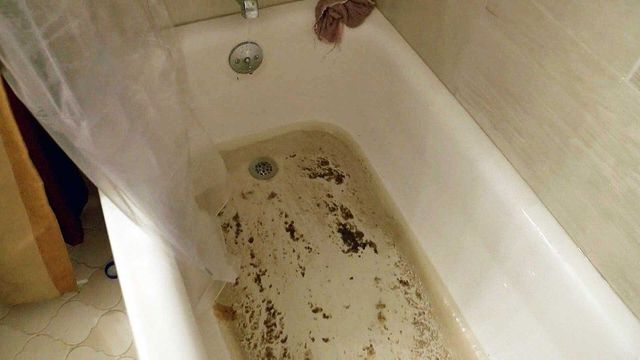We have stumbled upon this great article on What to Do if Sewage Starts Coming Up Through Your Bathtub directly below on the internet and think it made sense to quickly share it with you on this site.

Sewer back-up in the tub can be a distressing and unhygienic problem for any property owner. Not only is it inconvenient, yet it additionally postures significant health and wellness dangers and suggests underlying concerns with the plumbing system. Comprehending why sewage is turning up via the bathtub is crucial for taking proper activity to attend to the problem successfully.
Intro to the Concern
Recognizing the Trouble
When sewage draws back up right into the bathtub, it's a clear indicator of an issue with the drainage system. The wastewater that must be flowing away from your home is rather locating its way back into your space, which can lead to substantial damage and health hazards.
Possible Reasons
Numerous variables can contribute to sewer backup in the tub. From clogs in the drain line to concerns with the plumbing infrastructure, identifying the source is important for discovering an option.
Usual Factors for Sewer Back-up
Obstructions in the Sewer Line
One of one of the most common sources of sewer back-up is a blockage in the drain line. This can take place because of the build-up of debris, oil, or international objects in the pipes, preventing appropriate flow and creating sewer to support into your tub.
Tree Origin Breach
Tree roots seeking dampness and nutrients can penetrate drain lines through small cracks or joints. Gradually, these roots can grow and increase, causing considerable damage to the pipes and leading to sewer back-up problems.
Aging Framework
Older homes may have dated plumbing systems that are a lot more vulnerable to corrosion, fractures, and degeneration. As pipelines age, they become more prone to leaks and obstructions, enhancing the probability of sewer backup cases.
Heavy Rainfall or Flooding
During durations of heavy rainfall or flooding, the sewer system might end up being overloaded with excess water, causing backups and overflows. This can lead to sewer backing up right into bath tubs and other components inside the home.
Wellness Risks Related To Sewer Back-up
Contamination of Water Supply
Sewer back-up can contaminate the water supply in your house, presenting a major wellness threat to you and your household. Direct exposure to polluted water can result in stomach issues, skin infections, and various other ailments.
Spread of Disease
Sewer includes harmful bacteria, infections, and parasites that can trigger a variety of diseases, including hepatitis, cholera, and gastroenteritis. Entering contact with sewer or infected surface areas places you in jeopardy of infection.
Mold Growth
Dampness from sewage back-up can produce ideal conditions for mold and mildew development in your house. Mold spores can intensify respiratory problems and trigger allergies in delicate individuals, making punctual clean-up crucial.
Signs of Sewer Backup
Foul Odors
Unpleasant odors emanating from drains pipes or components, particularly in the bathroom, might indicate sewer backup problems. These smells are usually strong and persistent, indicating a problem that requires instant attention.
Slow Draining Fixtures
Tubs, sinks, and commodes that drain slowly or not whatsoever could be experiencing sewage back-up. If multiple components are affected all at once, it's likely that the issue originates from a common point, such as the primary drain line.
Gurgling Sounds
Unusual gurgling or gurgling noises coming from drains when water is running in other places in the house are a sign of air caught in the plumbing system. This air buildup can result from sewage backup and ought to be examined immediately.
Immediate Actions to Take
Switching Off Water System
In case of sewer back-up, it's essential to shut off the water to avoid additional contamination and damage. Locate the major water shutoff valve in your home and shut it off until the issue can be fixed.
Getting In Touch With a Professional Plumber
Taking care of sewer back-up is not a do it yourself task. Contact a certified plumber with experience in handling sewage-related concerns to assess the scenario and carry out essential fixings or cleanings.
Preventing Contact with Polluted Water
Up until the sewer back-up is solved, stay clear of contact with infected water to prevent the spread of bacteria and virus. Use protective gear if you have to remain in the affected location and clean your hands completely afterward.
Preventive Measures
Routine Maintenance of Sewer Lines
Arrange routine evaluations and maintenance of your drain lines to identify and attend to possible issues prior to they rise into significant problems. This can consist of cleaning particles, evaluating for tree origin breach, and fixing any kind of broken pipes.
Mounting Backwater Valves
Take into consideration installing backwater valves in your plumbing system to prevent sewer from receding right into your home during periods of heavy rainfall or flooding. These shutoffs instantly close when water starts backing up, securing your home from contamination.
Proper Disposal of Home Waste
Stay clear of purging anything apart from toilet paper and human waste down the toilet to prevent blockages and blockages in the drain line. Dispose of oil, oil, and various other family chemicals appropriately to minimize the danger of plumbing problems.
Tidying up After Sewer Backup
Sanitation Procedures
Completely sanitize and disinfect impacted areas after sewer back-up to get rid of unsafe bacteria and protect against mold development. Usage ideal cleansing items and safety equipment to make sure risk-free and efficient cleaning.
Repair of Influenced Areas
Fix any damages to flooring, walls, or fixtures triggered by sewer backup. Relying on the level of the damage, you may require to change carpeting, drywall, or various other products to recover your home to its pre-loss condition.
Why Is Water Backing Up in My Bathtub When I Flush My Toilet?
What to do about a sewer line clog
First, don’t bother with plunging. No amount of plunging will dislodge the clog in a sewer line. The clog is too far away. Plungers are for clogs in the toilet itself, not the sewer line. Plus, the most likely causes of a sewer clog are:
Tree roots Flushed toys or feminine products Grease buildup Those items don’t move easily. And in the case of tree roots, the roots need to be cut out of the pipe and the pipe will need to be repaired.
You’ll need a closet auger. A closet auger is a type of plumber’s snake with a protective cover to keep from scratching the delicate porcelain toilet. If the clog is further down, you may need to remove the toilet or use one of your cleanouts to get to the clog.
We also recommend doing a video inspection of the drain to ensure that the cause of the clog has been completely removed. Otherwise, you could have the same problem again in a few days or weeks.
https://mspplumbingheatingair.com/blog/why-is-water-backing-up-in-my-bathtub-when-i-flush-my-toilet

I am just very interested in and I hope you liked my entry. So long as you enjoyed our blog posting please do not forget to pass it around. I appreciate your readership.
Contact Us